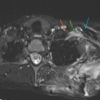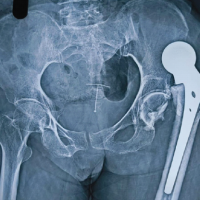Digital orthopedics, a burgeoning field at the intersection of telemedicine, digital imaging, and artificial intelligence, aims to enhance the precision and efficiency of orthopedic care. Nonetheless, it confronts notable challenges, including the need to ensure equitable access to these technologies while upholding stringent data security and privacy standards.
Dr Madhan Jeyaraman, Department of Orthopaedics, ACS Medical College and Hospital, Dr MGR Educational and Research Institute, Chennai, Tamil Nadu, India. E-mail: madhanjeyaraman@gmail.com
Orthopedics, the medical specialty dedicated to diagnosing, treating, and preventing disorders of the musculoskeletal system, has long been a cornerstone of healthcare. With an aging population and an increasing emphasis on maintaining an active lifestyle, the demand for orthopedic care is on the rise. However, the field of orthopedics is rapidly evolving, and one of the most significant developments in recent years is the emergence of digital orthopedics [1,2]. This transformation is reshaping the way orthopedic care is delivered, from diagnosis and treatment to patient outcomes and beyond. In this editorial, we explore the concept of digital orthopedics, its implications, and the potential benefits it offers to both patients and health-care professionals.
Digital orthopedics, also known as orthopedic informatics or orthopedic digital health, refers to the integration of digital technology into orthopedic care and practice [2]. It encompasses a wide range of tools and solutions, including telemedicine, digital imaging, wearable devices, mobile apps, artificial intelligence (AI), and data analytics. The goal is to enhance the efficiency, accuracy, and accessibility of orthopedic care, ultimately improving patient outcomes and reducing healthcare costs. The strategies of digital orthopedics are as follows.
Telemedicine has played a pivotal role in the digital transformation of orthopedics. With the advent of high-speed internet and secure communication platforms, patients can now consult with orthopedic specialists from their homes. This not only eliminates the need for long, often inconvenient commutes but also ensures that patients receive timely and expert advice. Telemedicine is particularly valuable in cases of post-operative follow-up, routine consultations, and non-urgent orthopedic concerns. Patients can share their symptoms, medical history, and images with their orthopedic providers through video calls or secure messaging, enabling efficient remote monitoring and decision-making [3]. Furthermore, it bridges the gap between patients and specialists, making orthopedic expertise more accessible, especially in remote or underserved areas.
Digital imaging technologies, such as X-rays, magnetic resonance imaging, and computed tomography scans, have long been indispensable in orthopedics. These images are essential for diagnosing conditions such as fractures, osteoarthritis, and ligament injuries. The transition from traditional film-based radiography to digital imaging has brought numerous advantages, including quicker image acquisition, reduced radiation exposure, and enhanced image storage and sharing capabilities [4]. In addition to digital imaging, computer-aided diagnostic tools are becoming increasingly sophisticated. AI algorithms can assist orthopedic specialists in interpreting medical images and detecting abnormalities with remarkable accuracy. These tools help speed up diagnosis and enable early intervention, ultimately improving patient outcomes.
The integration of wearable devices and mobile apps in orthopedic care has empowered patients to actively participate in their treatment and rehabilitation [5]. Wearables such as fitness trackers and smartwatches can monitor physical activity, gait, and even sleep patterns, providing orthopedic professionals with valuable insights into a patient’s lifestyle and overall health. Mobile apps, on the other hand, offer customized exercise regimens and educational resources for patients recovering from orthopedic surgeries or managing chronic conditions. These tools facilitate remote monitoring and adherence to prescribed rehabilitation programs, promoting faster recovery and better compliance.
AI and data analytics are revolutionizing orthopedics by enabling predictive and personalized care. AI algorithms can analyze large datasets of patient information to identify trends and predict outcomes [6]. For example, they can help orthopedic surgeons predict the success of joint replacements or estimate the risk of complications in specific patient populations. Furthermore, data analytics can uncover insights that improve health-care delivery and resource allocation. By examining patient demographics, treatment outcomes, and cost-effectiveness, health-care organizations can make data-driven decisions to optimize orthopedic care . With the help of AI, it is possible to create orthopaedic 3D imaging models, virtual orthopaedic journal clubs, symposiums, CMEs, and webinars for educating orthopods over the globe.
Three-dimensional printing has transformed orthopedic surgery, enhancing preoperative planning and educational methods [7]. It is particularly impactful in pediatric orthopedics for replicating complex deformities and enabling patient-specific surgical approaches [8,9]. Virtual orthopedic journal clubs, popularized during the COVID-19 pandemic, have become key in developing critical appraisal skills of orthopedic literature [10]. These clubs have proven effective in enhancing the ability of residents and attendings to critically evaluate scientific papers [11], with success dependent on engagement and paper selection [12]. The shift to telemedicine and virtual learning in orthopedic education, accelerated by the pandemic, has been met with mixed reactions from trainees [13]. Telemedicine has emerged as a feasible, cost-effective option for orthopedic consultations [14], while the transition to virtual teaching has had varied impacts on training programs, as evidenced by diverse resident experiences [15].
The integration of digital technology into orthopedics brings a multitude of benefits to patients, health-care providers, and the health-care system as a whole [16-20].
Digital orthopedics significantly improves access to orthopedic care. Patients no longer need to wait for an in-person appointment, and those in remote or underserved areas can connect with specialists without traveling long distances. Telemedicine and remote monitoring options ensure that patients receive timely care and advice, ultimately leading to better outcomes.
The use of digital imaging and AI-powered diagnostic tools increases diagnostic accuracy and reduces the likelihood of missed or incorrect diagnoses. These technologies help orthopedic specialists identify subtle abnormalities in medical images and provide precise recommendations for treatment.
With the assistance of AI and data analytics, orthopedic care can be tailored to individual patient needs. Treatment plans can be optimized based on patient demographics, risk factors, and predictive models, resulting in better outcomes and cost-effective care.
Patients undergoing orthopedic surgeries or managing chronic conditions can benefit from remote monitoring and rehabilitation programs delivered through wearable devices and mobile apps. These tools enhance patient engagement and adherence to treatment regimens, leading to quicker recovery and improved quality of life.
Digital orthopedics can contribute to reducing health-care costs. Timely interventions, personalized treatment plans, and remote monitoring help prevent complications and unnecessary hospital readmissions. Furthermore, telemedicine can cut down on the overhead costs associated with in-person consultations and hospital stays.
While digital orthopedics holds great promise, it is not without its challenges and considerations, which are as follows [18,21-23].
Not all patients have equal access to digital technology, which can exacerbate health disparities. Health-care organizations and policymakers must address these disparities to ensure that all patients have the opportunity to benefit from digital orthopedics.
The collection and sharing of patient data, particularly in telemedicine and remote monitoring, raise concerns about data security and patient privacy. Health-care providers and technology companies must implement robust security measures to protect sensitive patient information.
Health-care professionals need the training to utilize digital tools in orthopedics effectively. The rapid evolution of technology means that continuous education and adaptation are essential to providing high-quality care.
The regulatory landscape for telemedicine and digital health is still evolving. Health-care organizations and technology providers must navigate a complex web of regulations and standards to ensure compliance and patient safety.
Digital orthopedics is at the forefront of a health-care revolution that promises to make orthopedic care more accessible, efficient, and effective. By integrating digital technology into orthopedic practice, patients can expect improved access to care, enhanced diagnostic accuracy, personalized treatment plans, and remote monitoring and rehabilitation. Moreover, the potential for cost reduction and improved patient outcomes holds great promise for the future of orthopedic healthcare. As the field of orthopedics continues to evolve in the digital age, health-care organizations, providers, and policymakers must work together to address challenges related to technology access, data security, training, and regulatory frameworks. By doing so, they can ensure that digital orthopedics reaches its full potential and continues to benefit patients and the health-care system as a whole.
- The integration of digital technologies such as telemedicine, AI, and wearable devices in orthopedics significantly improves patient access, diagnostic accuracy, and treatment personalization.
- Digital orthopedics facilitates remote monitoring and rehabilitation, offering benefits like better patient engagement, faster recovery, and improved quality of life for those undergoing orthopedic treatment or managing chronic conditions.
- To fully harness the benefits of digital orthopedics, it is crucial to overcome challenges related to equitable technology access, data security, and privacy, as well as to adapt to evolving regulatory frameworks.
References
- 1.Bini SA, Schilling PL, Patel SP, Kalore NV, Ast MP, Maratt JD, et al. Digital orthopaedics: A glimpse into the future in the midst of a pandemic. J Arthroplasty 2020;35:S68-73. [Google Scholar]
- 2.Li Z. Digital orthopedics: The future developments of orthopedic surgery. J Pers Med 2023;13:292. [Google Scholar]
- 3.Foni N, Costa LA, Velloso LM, Pedrotti CH. Telemedicine: Is it a tool for orthopedics? Curr Rev Musculoskelet Med 2020;13:797-801. [Google Scholar]
- 4.Baxi S, Shadani K, Kesri R, Ukey A, Joshi C, Hardiya H. Recent advanced diagnostic aids in orthodontics. Cureus 2022;14:e31921. [Google Scholar]
- 5.Constantinescu D, Pavlis W, Rizzo M, Vanden Berge D, Barnhill S, Hernandez VH. The role of commercially available smartphone apps and wearable devices in monitoring patients after total knee arthroplasty: A systematic review. EFORT Open Rev 2022;7:481-90. [Google Scholar]
- 6.Farhadi F, Barnes MR, Sugito HR, Sin JM, Henderson ER, Levy JJ. Applications of artificial intelligence in orthopaedic surgery. Front Med Technol 2022;4:995526. [Google Scholar]
- 7.Wong RMY, Wong PY, Liu C, Chung YL, Wong KC, Tso CY, et al. 3D printing in orthopaedic surgery: A scoping review of randomized controlled trials. Bone Joint Res 2021;10:807-19. [Google Scholar]
- 8.Raza M, Murphy D, Gelfer Y. The effect of three-dimensional (3D) printing on quantitative and qualitative outcomes in paediatric orthopaedic osteotomies: A systematic review. EFORT Open Rev 2021;6:130-8. [Google Scholar]
- 9.Jiang M, Chen G, Coles-Black J, Chuen J, Hardidge A. Three-dimensional printing in orthopaedic preoperative planning improves intraoperative metrics: A systematic review. ANZ J Surg 2020;90:243-50. [Google Scholar]
- 10.Aweid B, Haider Z, Wehbe M, Hunter A. Educational benefits of the online journal club: A systematic review. Med Teach 2022;44:57-62. [Google Scholar]
- 11.Clesham K, Piggott RP, Sheehan E. A prospective review of a novel electronic journal club format in an orthopedic residency unit. J Surg Educ 2020;77:115-23. [Google Scholar]
- 12.Campbell ST, Kang JR, Bishop JA. What makes journal club effective?-a survey of orthopaedic residents and faculty. J Surg Educ 2018;75:722-9. [Google Scholar]
- 13.Al-Kulabi A, Mansour MA, Thahir A. The orthopaedic experience of COVID-19: A literature review. J Perioper Pract 2021;31:102-7. [Google Scholar]
- 14.Tanaka MJ, Oh LS, Martin SD, Berkson EM. Telemedicine in the Era of COVID-19: The virtual orthopaedic examination. J Bone Joint Surg Am 2020;102:e57. [Google Scholar]
- 15.Kruse C, Gouveia K, Thornley P, Yan JR, McCarthy C, Chan T, et al. COVID-19 and the transition to virtual teaching sessions in an orthopaedic surgery training program: a survey of resident perspectives. BMC Med Educ 2022;22:655. [Google Scholar]
- 16.Ram PR, Jeyaraman M, Jeyaraman N, Yadav S, Venkatasalam R. Revolutionizing orthopedic healthcare: The role of robotics. Cureus 2023;15:e44820. [Google Scholar]
- 17.Pai SN, Jeyaraman M, Jeyaraman N, Nallakumarasamy A, Yadav S. In the hands of a robot, from the operating room to the courtroom: The medicolegal considerations of robotic surgery. Cureus 2023;15:e43634. [Google Scholar]
- 18.Halm-Pozniak A, Lohmann CH, Zagra L, Braun B, Gordon M, Grimm B. Best practice in digital orthopaedics. EFORT Open Rev 2023;8:283-90. [Google Scholar]
- 19.Merle G, Parent-Harvey A, Harvey EJ. Sensors and digital medicine in orthopaedic surgery. OTA Int 2022;5:e189. [Google Scholar]
- 20.Chen YX, Zhang K, Hao YN, Hu YC. Research status and application prospects of digital technology in orthopaedics. Orthop Surg 2012;4:131-8. [Google Scholar]
- 21.Warner JJ, Ticker JB, Navarro RA, Haas DA, Dremel E, Roop JA. The business of orthopedics: Post-pandemic challenges and opportunities-a Codman shoulder society discussion. J Orthop Experience Innov 2020;1:(2): https://doi.org/10.60118/001c.17393. [Google Scholar]
- 22.Niculescu M, Honțaru OS, Popescu G, Sterian AG, Dobra M. Challenges of integrating new technologies for orthopedic doctors to face up to difficulties during the pandemic Era. Healthcare (Basel) 2023;11:11524. [Google Scholar]
- 23.Pei GX, Yan YB. Current status and progress of digital orthopaedics in China. J Orthop Transl 2014;2:107-17. [Google Scholar]









